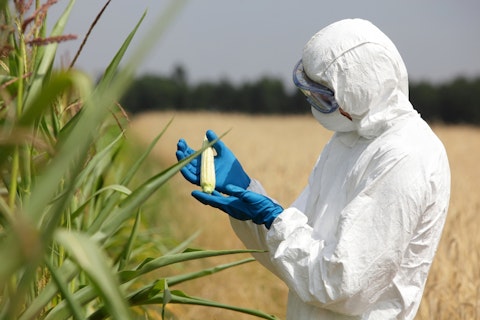In this article, we shall discuss the 10 most consumed genetically modified crops in the US. To skip our detailed analysis of the advances in bioengineering, how it relates to modern agriculture, and the scope for genetically modified crops in 2024, go directly and see 5 Most Consumed Genetically Modified Crops in the US.
The Move Towards Sustainable Agriculture: An Overview
According to a report by McKinsey, sustainable farming practices are integral to global decarbonization efforts. However, if the world is to achieve net-zero, the agriculture industry must take drastic action along the entire value chain. Major players in the agriculture industry like Nutrien Ltd. (NYSE:NTR), Archer Daniels Midland Company (NYSE:ADM) and Bunge Limited (NYSE:BG) are embracing this global transition and diverting increased investments in sustainable farming practices in accordance with local regulations by focusing on some of the most consumed genetically modified crops in the US. To read more on companies paving the way towards sustainable agriculture, read our article on 12 Biggest Agriculture Companies in the World. The report states that agricultural land encompasses more than half of all habitable land is is single handedly responsible for more than 70% withdrawals from freshwater resources. Additionally, food systems are one of the most significant drivers of biodiversity degradation across the globe. These systems also have a major impact upon biosphere integrity, human health, and food access. The report by McKinsey makes it clear that achieving the 1.5° objective will require actions that extend across the entire value chain of the agribusiness industry. These actions include a sustainable reduction of food loss and waste, the adoption and integration of dietary shifts, and increased adaptability and resilience to the use of arable land. Increased investments in producing some of the most consumed genetically modified crops in the US are integral to decarbonization imperatives and will enable the industry to sustainably meet global food needs whilst maintaining the livelihood of the industry’s workforce.
The report also highlights the steps companies like Nutrien Ltd. (NYSE:NTR), Archer Daniels Midland Company (NYSE:ADM) and Bunge Limited (NYSE:BG) need to take to make a seamless transition to increased sustainability, one of which is implementing financial incentives to encourage greater involvement of farmers in the process of producing the most consumed genetically modified crops in the US. This incentivization structure can be built upon carbon markets, green premiums, subsidies, rebates, or other green-financing initiatives. Secondly, companies can also invest in the creation and maintenance of an atmosphere to collaboration and improved traceability to introduce sustainable solutions to the market and influence the commercialization of practice shifts on the farm and consumer decision making mechanisms. Lastly, companies can invest greater amounts of capital into research geared at bending the cost curve and producing the most consumed genetically modified crops in the US. This would be instrumental in reducing the implementation of existing technologies and support the development and scale up of new technologies. To read more on innovative ways in which the agriculture industry can rake in more revenue, check out our coverage of 15 New Innovative Agricultural Business Ideas.
GMOs and Building Sustainable Agricultural Practices: An Analysis
According to a report by McKinsey, major advancements in the realm of biological sciences are expected to catalyze development of computing, automation, and artificial intelligence in bringing in an era of innovation in industries across the world. Experts are predicting that the Bio Revolution is projected to have a substantial influence on the global economy, especially the agriculture industry. The increasing adoption of genetically modified organisms (GMOs) in the agriculture industry spells huge upside for companies operating within the sector, as GMOs result in increased productivity, and a decreased dependance upon chemical alternatives to control bug infestations. More than 90% of corn, soybeans, and cotton growth in the United States is genetically engineered. Furthermore, GMOs are ingredients in more than 80% of American processed food. And although scientists and regulators have time and again asserted that GMOs pose no serious risk to health and the environment, only 28 countries globally have planted genetically engineered crops, according to a report by Bloomberg.
According to another report by Bloomberg, GMOs also have a huge utility in global ESG imperatives. Russia’s invasion of Ukraine in February 2022 has created an enormous opposition to ESG imperatives in defense and conventional energy industries. Hence, for the foreseeable future, ESG advocates are likely to turn focus on food security as the next plain for ESG implementation. The report highlights that the increased use of genetic technology in the manufacture of seeds is of immense utility in this global transition to net-zero. Despite this fact, many ESG funds are increasingly skeptical about GMOs, fearing unintended consequences of undue intervention in the food chain. However, this position is incredibly unsustainable to maintain, especially since it poses the risk of sparking a global food crisis, causing many companies like Nutrien Ltd. (NYSE:NTR), Archer Daniels Midland Company (NYSE:ADM) and Bunge Limited (NYSE:BG) and investors to project that the ESG tide will soon make a drastic turn and favor some of the most consumed genetically modified crops in the US.
The report highlights that global crop demand is on track to be more than 60% higher than current levels in 2050. Although crop yields have been making a marked improvement in recent years, these gains would need to exponentially accelerate in order to avoid a shortage of supply, which could come as soon as 2030. If GMOs are not incorporated in farming practices soon, the cropland needed to meet demand would equal the combined land area of the U.K, France, Belgium, and the Netherlands. In this vein, the report ascertains that companies which integrate GMOs, especially seed and plant genetics, into their supply line could make more than $1.3 trillion of annual revenue by 2050. Furthermore, financial markets are projected to allocate increased capital in companies best positioned to avert an impending food crisis. However, governance needs to be of utmost priority here, especially since the requirement of deep R&D budgets means that crop science is likely to remain concentrated around a small number of influential players in the market like Nutrien Ltd. (NYSE:NTR), Archer Daniels Midland Company (NYSE:ADM) and Bunge Limited (NYSE:BG). Therefore, the industry needs active, long-term investors geared towards bringing intense levels of scrutiny towards the most consumed genetically modified crops in the US.
In this vein, the European Union has also introduced plans to soften regulations on GMOs in an effort to incentivize large-scale agriculture companies to divert greater investments into GMOs. This initiative, adopted under a wider mandate to encourage biodiversity and food sectors, is geared at making food systems more sustainable. The European Commission has signaled at integrating new genomic technologies (NGTs) which can boost crops’ tolerance to diseases, pests, and environmental stresses. Current regulators are unaware of developments like gene editing, which the bloc had previously named subject to the same policies as all GMOs. Although activists are adamant that these steps are integral in containing the exacerbation of climate change, certain elements purport that the producing some of the most consumed genetically modified crops in the US in Europe will boost seed prices and hurt consumers.

Marcin Balcerzak/Shutterstock.com
Our Methodology
To compile our list of the 10 most consumed genetically modified crops in the US, we decided to use data by the U.S. Food and Drug Administration (FDA), which tracks GMO consumption in the United States. We decided to use data by the U.S. Department of Agriculture to ascertain the acreage of each crop attributed to their genetically modified variety, with the primary assumption being that crops which post high consumption volumes naturally would be afforded more acreage in the US. We picked 10 crops which had the largest acreage attributed to their genetically modified variety, and ranked the crops based on total acreage, from lowest to highest. You can read about genetically modified crops in other countries in our article 15 Countries that Produce the Most Genetically Modified Crops.
To sum it up, we ranked the 10 most consumed genetically modified crops in the US based on the total acreage attributed to each crop’s genetically modified variety. By the way, Insider Monkey is an investing website that tracks the movements of corporate insiders and hedge funds. By using a similar consensus approach, we identify the best stock picks of more than 900 hedge funds investing in US stocks. The top 10 consensus stock picks of hedge funds outperformed the S&P 500 Index by more than 140 percentage points over the last 10 years (see the details here). Whether you are a beginner investor or professional one looking for the best stocks to buy, you can benefit from the wisdom of hedge funds and corporate insiders.
10 Most Consumed Genetically Modified Crops in the US
10. Papaya
Total Acreage: 30,000
Genetically modified papayas were first produced in the U.S. in 1996. Since then, they have been extremely popular in the country. The genetically modified papayas are known to be resistant to ringspot virus. This type of papaya was initially developed by a scientist in Cornell University and is majorly produced in Hawaii. Genetically modified papayas are also called ‘Rainbow Papayas’.
9. Squash
Total Acreage: 45,000
Genetically modified squash is one of the most consumed genetically modified crops in the US. Zucchini and yellow summer squash have been produced and used in the U.S. since around 1994 to 1996. According to data available, there are approximately 25,000 acres of farmland to produce genetically modified squash in the U.S. Genetically modified squash is produced for resistance to specific plant diseases, including zucchini yellow mosaic virus and watermelon mosaic virus.
8. Apples
Total Acreage: 332,000
Genetically modified apples have been extremely popular in the U.S., especially because the genetic modification of the DNA prevents the browning of an apple, even after it has been sliced. The Food and Drug Administration (FDA) has approved genetically modified apples and have termed them to be safe to eat. The first genetically modified apple was approved in 2015.
7. Potatoes
Total Acreage: 901,000
Fairly recently, the United States started the production of genetically modified potatoes. This variant of potatoes is resistant to bruising and producing a lesser amount of a cancer-causing chemical, called acrylamide. Currently, genetically modified potatoes are not available for food, but only for industrial use. These potatoes were approved by the Food and Drug Administration (FDA) in 2015.
6. Sugar Beets
Total Acreage: 1.16M
Since 2008, the United States has been producing genetically modified sugar beets. More than half of the granulated sugar in the U.S. is produced using sugar beets. Genetically modified sugar beets are produced by modifying their genome via biotechnology. Due to certain safety concerns, the production and use of genetically modified sugar beets was stopped; however, it resumed in 2011. Sugar beets are number 6 on our list of the most consumed genetically modified crops in the US.
Click here to continue reading and see 5 Most Consumed Genetically Modified Crops in the US.
Suggested Articles:
- 10 Countries That Will Disappear by 2050
- 15 Stocks That Will Make You Rich in 5 Years According to ChatGPT
- These Stocks under $10 Are Poised To Explode
Disclosure: None. 10 Most Consumed Genetically Modified Crops in the US is originally published on Insider Monkey.




